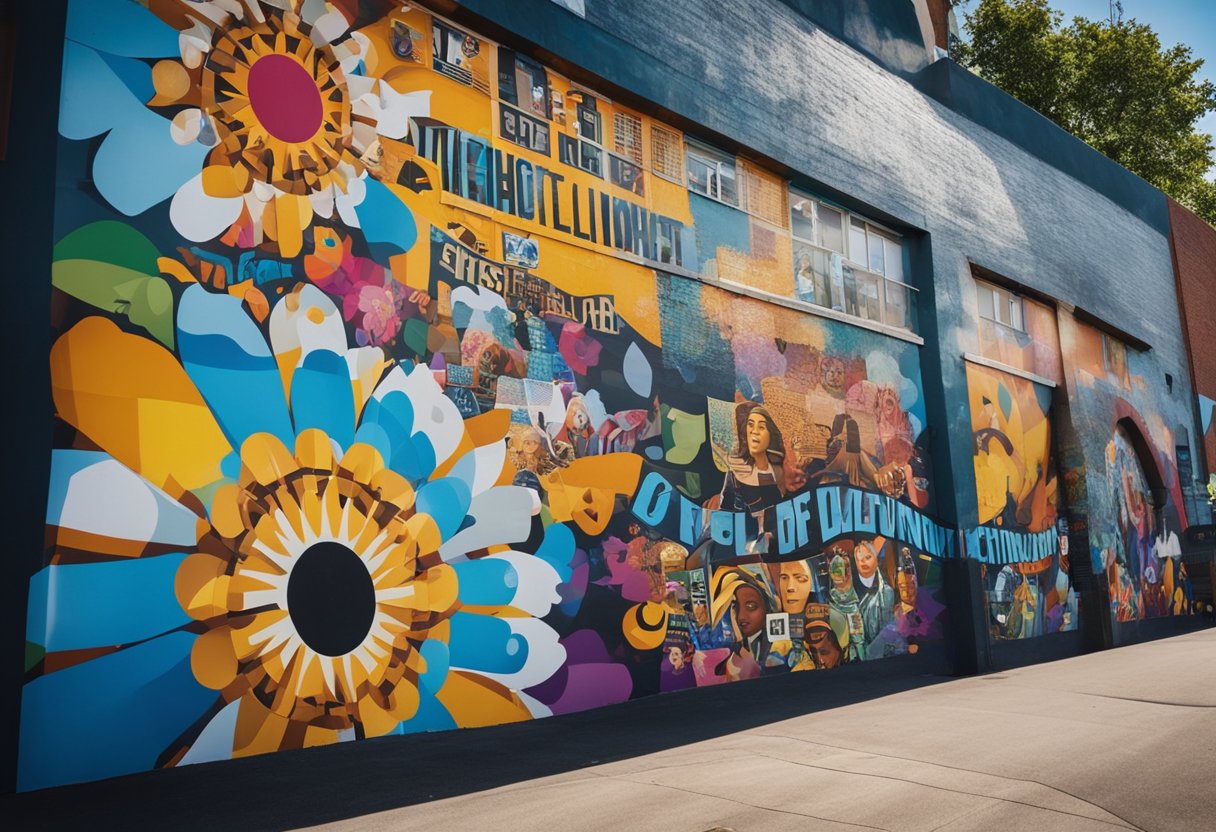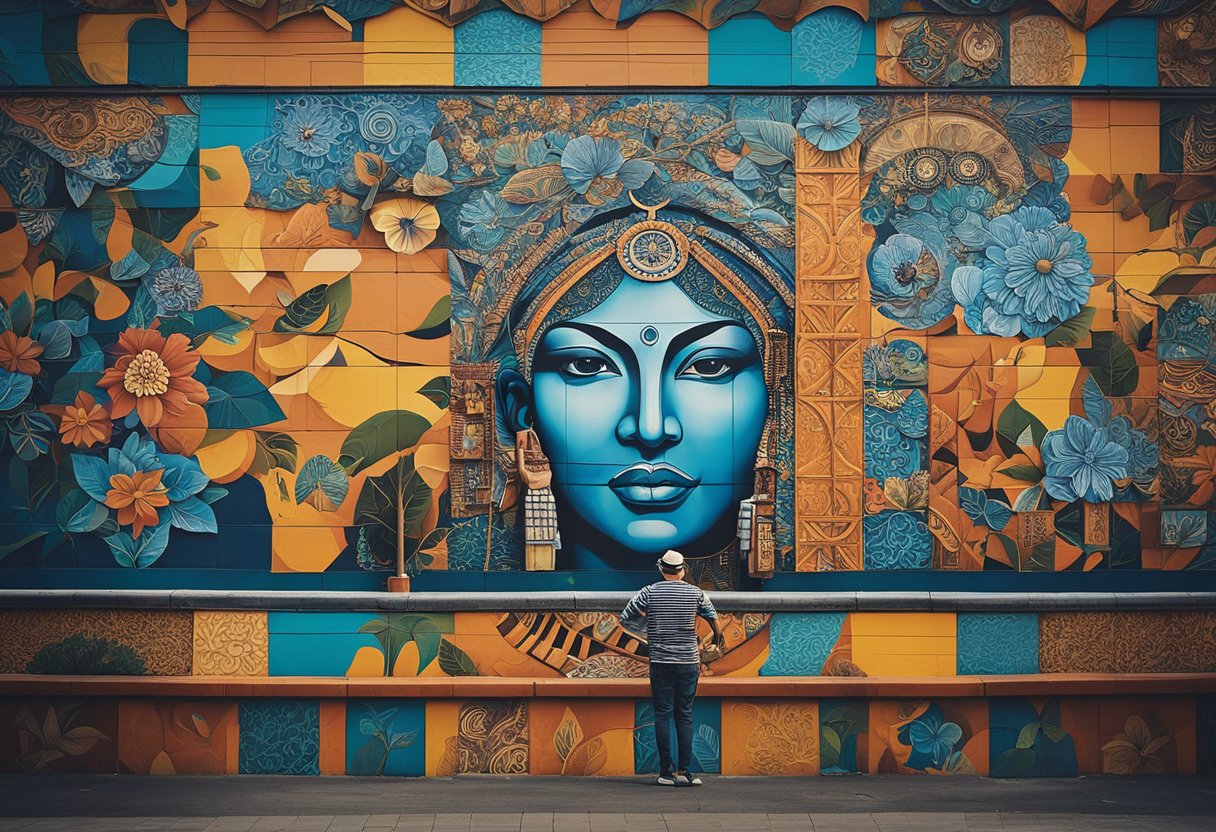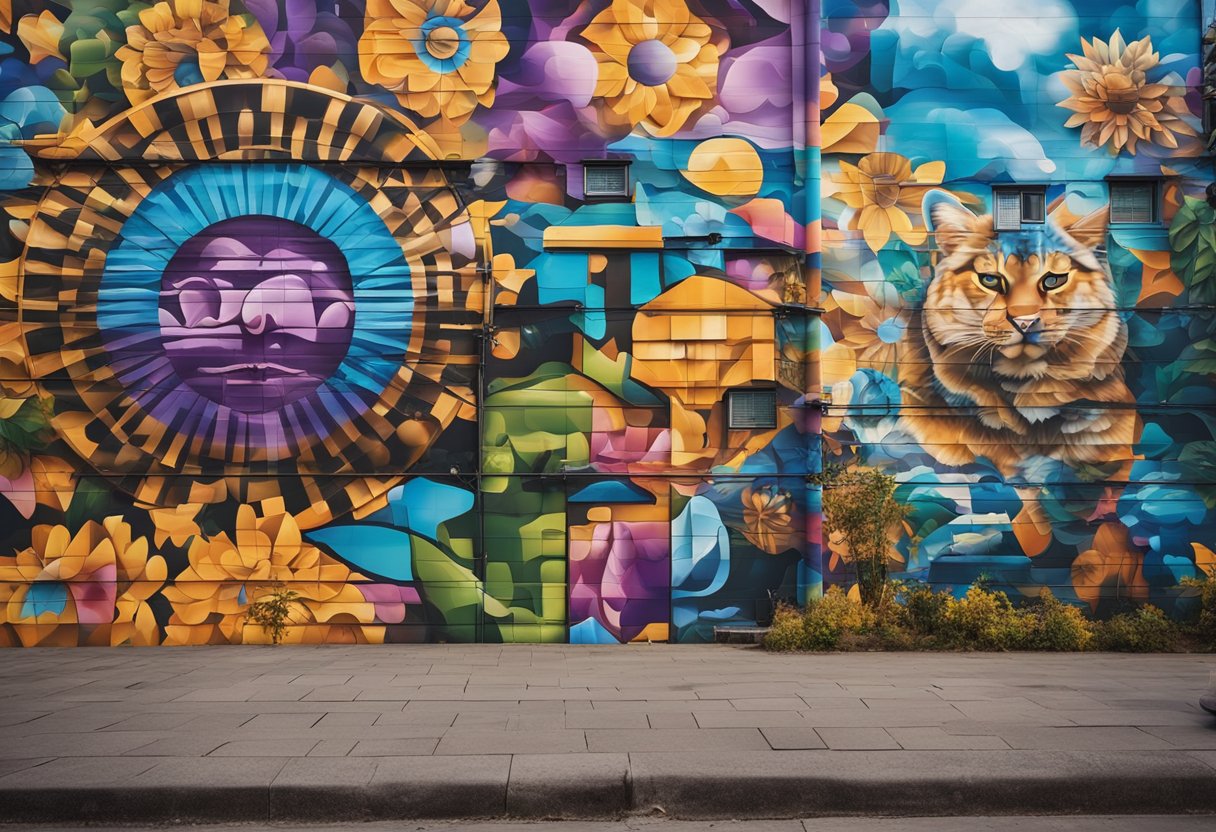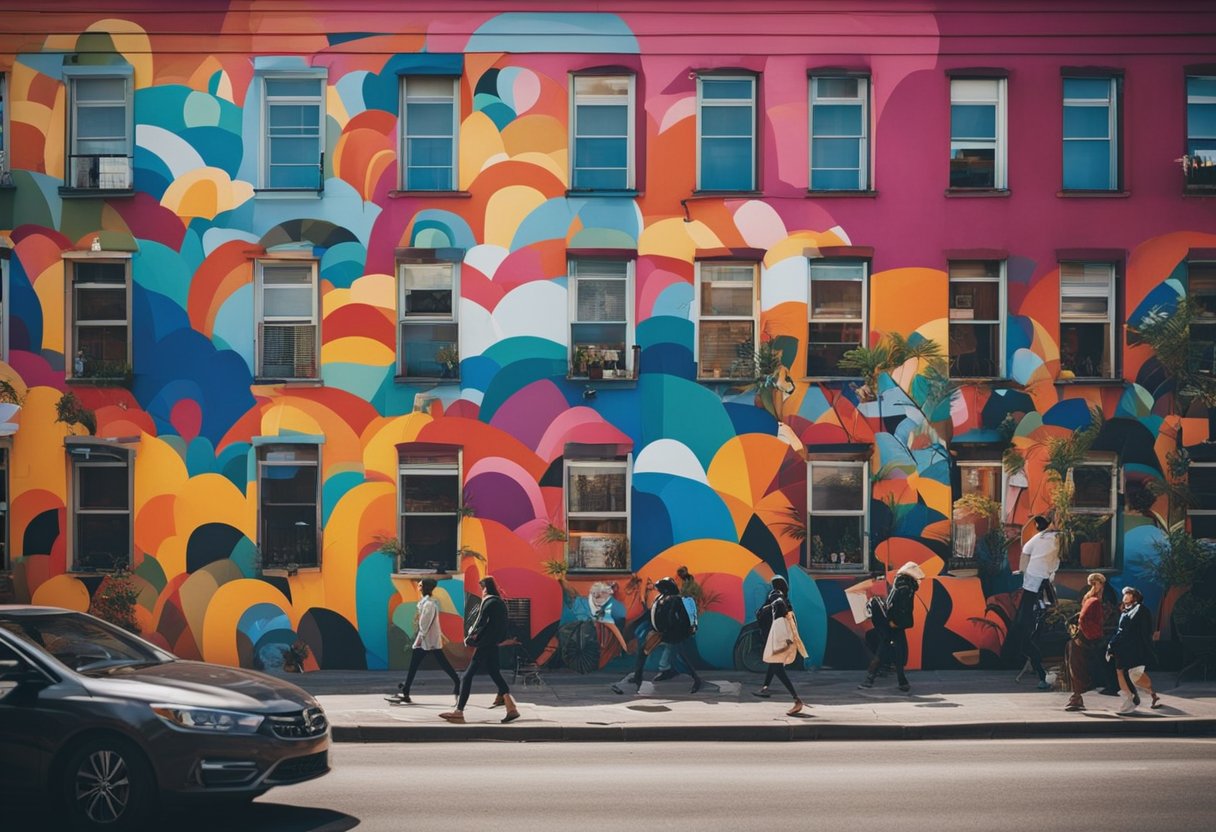Street Art and Social Change: Exploring Impactful Murals Worldwide

Updated On: April 15, 2024 by Eman Sameh
Street art has emerged as a powerful facilitator of social change, transforming urban landscapes into canvases that communicate potent messages to a wide audience. These vibrant murals often encapsulate the voice of the community, transcending mere visual appeal to stir public consciousness and spark discourse. Throughout history, street art has played a significant role in political movements, capturing the ethos of societal upheaval or the spirit of collective unity.

This visual phenomenon profoundly extends beyond aesthetics, impacting culture and public dialogue. Murals can be educational, bringing attention to crucial issues, fostering awareness across various strata of society, and even inspiring global environmental movements. As communities and artists collaborate, the streets become a gallery of public opinion, reflecting the tensions, aspirations, and dreams of the masses. What began as an underground movement has evolved into a critical medium for advocacy and expression that reaches beyond the constraints of traditional galleries.
The Origins of Street Art
Street art has a dynamic history that intertwines with the urban environment. Originating from graffiti, which itself began as a basic form of tagging by individuals or groups to mark territory or to make statements, it has evolved into a diverse range of visual expressions.
- 1970s: This decade saw the birth of street art as we know it, with individuals leaving their unique mark on their surroundings using stencils, paint, and creativity. Artists like Blek le Rat popularised stencil graffiti, laying the groundwork for future artists like Banksy.
- 1980s: The movement gained prominence as a tool for social change and cultural expression. New York subways became canvases for vibrant artworks, although authorities often viewed them as vandalism.
- 1990s and beyond: Street art became increasingly accepted and sometimes commissioned, symbolising a shift from vandalism to valued cultural commentary.
While early graffiti artists used public spaces to display art often without permission, modern street artists occasionally receive invitations to create murals in specific locations. These evolving attitudes towards street art reflect a growing recognition of its potential to provoke thought and inspire social change. Crucial to the spirit of our collective creativity, street art has become a critical facet of cultural dialogue in urban landscapes worldwide.
Street Art as a Voice for Communities
Street art has emerged as a potent medium through which communities express their identity, challenges, and aspirations. It is an accessible form of visual communication, often bringing attention to issues otherwise overlooked.
Empowering Neglected Neighbourhoods
In many cities, neglected neighbourhoods have been revitalised through the vibrant hues of street murals. We see decrepit walls turning into canvases that not only beautify the area but also foster a sense of pride among residents. For instance, an artists’ collective in Pachuca, Mexico, transformed Las Palmitas into a colourful mural, catalysing a united community and altering the neighbourhood’s reputation.
Artists as Activists for Social Issues
Activism through street art takes on a compelling form as artists become the voice for social change. Their murals often address pressing societal concerns, engaging the public in an ongoing dialogue. In Mexico, street artists use their work to comment on political and social issues, strengthening the bond between art and community action.
Prominent Murals and Their Messages

Street art has become an influential platform for social commentary, with murals worldwide acting as catalysts for discussion and change. The power of these visual creations lies in their ability to bring political and social issues to the forefront of public consciousness, narrating stories of resistance, injustice, and hope.
George Floyd Mural and the Fight for Racial Justice
In the wake of George Floyd’s death, a mural emerged on a street corner in Minneapolis as a solemn reminder and a symbol of the fight for racial justice. This poignant piece depicts Floyd’s face, and around it, the names of many other victims of racial violence are listed, making it not just a memorial but a stark beacon of the relentless pursuit for equality. The mural has become a hallowed place for protest and reflection, honouring Floyd’s memory and the global movement it ignited.
Banksy’s Political Statements
Banksy, a clandestine yet world-renowned artist, uses street murals to deliver powerful political statements. His work is often laced with satirical undertones, critiquing everything from war to consumerism and environmental issues. Banksy’s art transcends mere aesthetics; it forces us to confront the uncomfortable realities of our society. The elusiveness of the artist only adds to the weight of his messages, making his murals a profound commentary on contemporary issues.
Street Art and Political Movements
Street art has become an influential tool in political movements around the globe. What often begins as a form of self-expression can transform into a powerful act of social commentary and revolution. As we examine the intersection between street art and political activism, we see murals that have spurred conversations and inspired collective action.
Activists have long harnessed the visual power of street art to promote messages of freedom and change. These pieces often evoke emotions and foster solidarity among observers, transcending language and cultural barriers. In recent times, the Black Lives Matter movement has been particularly emblematic of this, with murals of George Floyd becoming focal points of protest and remembrance.
Murals serve as beacons of public awareness, delivering hard-hitting truths in vibrant colours and bold lines. They often emerge in urban environments—on the sides of buildings, under bridges, and along public streets—providing unmissable and provocative narratives for all who pass by. For instance, social justice murals can amplify voices in the fight for equality and civil rights, becoming symbols of perseverance and unity within communities.
As we observe these expressions of street art, we recognise their role in shaping the cultural landscape. Their presence in public spaces underscores the strength of visual mediums in rallying support for political causes and fostering a collective sense of purpose. Through this, street art continues to stand as both an artistic and political force, echoing the voices of the marginalised and propelling movements forward.
The Role of Murals in Public and Political Discourse
Murals have become instrumental in shaping public and political discourse, offering a canvas for street artists to provoke thought and inspire action on critical social issues.
Walls of Justice and Activism
Murals serve as powerful Walls of Justice, promoting police accountability and social equity. Public art in the form of murals often becomes a focal point for activism, capturing the attention of passers-by and amplifying the message of social movements. For example, street artists have utilised city walls to visually communicate the urgency of justice in instances of police misconduct.
Art as a Catalyst for Hard Conversations
The Mural Arts Program and other similar initiatives facilitate Art as a Catalyst for Hard Conversations. By painting thought-provoking imagery in public spaces, these murals spark engagement and dialogue among community members. The compelling visuals compel us to confront challenging issues and can catalyse community-wide discussions on topics that may otherwise be avoided.
Cultural Impact of Street Art
Street art has become a significant cultural phenomenon, influencing not only the aesthetics of urban landscapes but also the social and economic aspects of cities worldwide. We’ll explore its effect on tourism and economy and the global recognition it has garnered.
Influence on Tourism and Economy
Street art serves as an accessible luxury for both the casual traveller and the serious art academic. These vivid murals transform ordinary streets into open-air galleries, attracting a diverse range of tourists. Cities benefit as visitors, drawn by the allure of these visual spectacles, spend money in local businesses, bolstering revenue. For instance, the street art in Melbourne has famously become a major tourist attraction, often featured on the cover of travel guides. As tourists flock to these painted streets, they pump money into the region, enhancing the local economy.
Global Recognition of Street Art
In recent years, street art has attained global recognition, shifting from being seen as simple vandalism to a form of respected public artistry. This evolution in perception has seen cities around the world embrace street art as a means to revitalise neighbourhoods, foster community pride, and address social and environmental issues, such as global warming. Street art festivals and commissioned murals are now regular occurrences in many parts of the world, celebrating the cultural impact of this art form on a global stage. Cities known for their street art, like Berlin, have gained prestige and an innovative identity that is recognized all over the planet.
Educational Initiatives and Workshops
In the realm of street art, the significance of educational initiatives and interactive workshops cannot be understated. Such programmes are pivotal for fostering awareness and contributing to positive change within communities.
Workshop Activities
- Creating murals with messages of social justice
- Discussing the history and impact of street art
- Learning new artistic skills and techniques
Through these initiatives, participants—ranging from school children to adults—gain a better understanding of the potential of art to address social issues. They are also an opportunity for artists to engage directly with the public, creating a platform for meaningful dialogue and exchange.
Objectives
- To impart artistic skills that empower individuals
- To utilise art as a tool for critical thinking
- To raise awareness on key societal issues
During these events, practical skills are taught that both nurture creativity and encourage critical discourse. The result is often a series of compelling murals, reflective of the collective community’s aspirations for change.
By involving people in the process of creating street art, we essentially equip them with a new language of expression. This hands-on involvement makes the experience more personal, often translating into a stronger commitment to the cause depicted.
Moreover, such workshops underscore the crucial role played by art education in stirring public consciousness and promoting civic engagement. They provide a powerful testament to the transformative power of art, especially within public spaces.
Street Art, Law Enforcement and Vandalism
In our exploration of street art, it’s critical to understand its interplay with law enforcement and perceptions of vandalism. This intricate dance between artistic expression and legality shapes the urban landscape and community interactions within public spaces.
Graffiti and Public Perception
Graffiti often strides a fine line between being seen as vandalism or a legitimate art form. Originally, graffiti in public spaces was widely viewed as an illegal act of defacement, with law enforcement agencies associating it with gang activity and a decline in neighbourhood safety. Over time, the perception has shifted in many communities, with street art becoming more recognised for its ability to convey powerful social messages and transform dull urban environments into vibrant public galleries.
Policing and Community Relations
Law enforcement’s approach to street art is multifaceted, involving both the reduction of vandalism and the fostering of community relations. While police work to uphold laws that protect public and private property, a surge in police brutality cases globally has necessitated a delicate balance. Positive engagement between police and community artists can lead to sanctioned murals that celebrate cultural identity and address social issues, turning potential sites of conflict into collaborative public art projects.
Street Art Inspiring Social and Environmental Change
Street art has emerged as a powerful medium for raising awareness and fostering change on critical global issues such as climate change and social disparities.
Climate Change Awareness Through Art
Artists around the world are using murals as a canvas to visually communicate the urgency of climate action. These public artworks often deploy striking imagery to depict the impacts of global warming, influencing public opinion and inspiring positive reform in environmental policies. For instance, street art can bring to life the consequences of rising sea levels or the beauty of renewable energy solutions, catalysing community-led initiatives and driving awareness to the forefront of public consciousness.
Murals Promoting Peace and Hope
Murals serve as beacons of hope and peace, transforming blank walls into messages of harmony and unity. By encapsulating ideals of positive reform within their work, street artists encourage communities to reflect on peace and envision a world where it is the cornerstone of our collective experience. Public art promotes a sense of shared community, bridging divides and suggesting a more hopeful narrative for the future. Through these visual pieces, the conversation around peace is kept alive in the public eye, nudging societies towards conflict resolution and coexistence.
In these vibrant displays, street art transcends mere aesthetics, positioning itself as a catalyst for environmental awareness and societal peace.
The Digitalisation of Street Art

In an age where digital technology permeates every aspect of our lives, street art has found a new canvas on the internet. The digitalisation of this vibrant art form has not only increased its accessibility, but it has also provided new ways for people around the world to experience and interact with urban masterpieces.
Online Galleries and Virtual Tours
We’ve witnessed a significant shift from street art solely inhabiting the physical spaces of urban environments to populating online galleries and virtual spaces. These digital platforms allow enthusiasts to navigate through high-resolution images of street art from the comfort of their homes. Websites like Connolly Cove have expanded to showcase the diverse culture and art found in global hotspots, offering virtual tours that make street art more accessible than ever. The introduction of online galleries has bridged the gap between the art and global audiences, allowing people who may never have the chance to visit these artworks in person to appreciate them and learning about the artists behind the murals.
Street Art on Social Media
On social media, street art has found a dynamic and engaging platform, reaching wide-ranging demographics. Pages and profiles dedicated to street art allow us to share and comment on the latest murals, fostering a community that appreciates and supports this form of expression. Accessibility is further enhanced as artists can directly connect with their audience, offering behind-the-scenes content and discussing the themes of their work. Social media’s real-time nature means that new pieces of street art can become viral sensations overnight, sparking conversations and driving social change on a scale previously unimaginable.
Street Art Beyond the Western Lens
Exploring the world of street art through a global perspective offers insights into cultural narratives and social movements shaped by regions outside the traditional Western focus. The vibrancy and diversity of these expressions significantly contribute to the global tapestry of public art.
Influences and Movements in Africa and Asia
In Africa, the city of Dakar has become a canvas for artists, who utilise the bustling streets as a medium to broadcast Senegal’s rich heritage and contemporary challenges. Street art in Dakar serves as a mirror reflecting the socio-political climate while celebrating Senegal’s culture. Meanwhile, in Asia, cities like Moscow have witnessed an explosion of street murals that connect deeply with Russia’s intricate history and global conversations. This confluence of local and global themes within street art sparks a cultural exchange, providing a powerful site for local narratives to enter an international dialogue.
Cross-Cultural and International Dialogue
Engaging with street art across diverse cultures facilitates a unique intercultural dialogue, with murals often serving as the catalyst for cross-border conversations. The visual language of street art transcends linguistic barriers, enabling artists in locations such as Russia and Senegal to contribute to a global discourse on important social issues. These murals not only display the distinct identity of a locale but also become part of a greater narrative, fostering a shared understanding that resonates with audiences worldwide.
Frequently Asked Questions

In this section, we’ll explore some of the most pressing queries about street art’s impact on society, providing insight into its historical significance and the influential artists who’ve truly moved the masses.
What are some notable examples of street art that have contributed to social change?
One impactful piece is the Social Justice Murals, which artistically vocalise the struggles and advocate for the rights of marginalised communities. Another notable example includes Banksy’s works, which often offer a critical view of political issues, sparking public discourse.
What are the various forms of street art typically seen in urban landscapes?
Urban landscapes feature a diverse array of street art forms, from murals and graffiti to stickers, stencils, and installations. These forms transform communities, reflecting their unique character and issues.
Who are some prominent graffiti artists known for their role in political and social activism?
Artists like Banksy, Shepard Fairey, and Blu are renowned for their work in political and social activism, utilising their art to challenge viewers’ perceptions and encourage societal reflection.
How has the history of street art evolved alongside political and social movements?
The history of street art has been intertwined with political and social movements since its inception, from cave paintings to contemporary murals that address issues such as inequality and injustice.
In what ways have murals been used as tools for societal impact and dialogue?
Murals have served as a means of fostering dialogue and addressing social justice, depicting the stories and histories that might otherwise go unheard, and empowering communities to express their collective voice.
How does the distinction between street art and graffiti relate to their individual influences on culture and society?
The distinction often hinges on issues of legality and perception; graffiti is frequently seen as subversive, while street art is considered more mainstream. Both, however, have influenced culture and society, provoking thought, conversation, and in many cases, progressive change.






